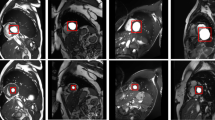Abstract
Left ventricular segmentation in cardiac magnetic resonance images is considered as the most critical method to evaluate the cardiac function. In this paper, a hybrid method has been proposed to segment the left ventricle(endocardium). In this study, first, a new method has been proposed based on deep Convolutional Neural Network (CNN) to localize the LV in cardiac MRI. Then, the segmentation is completed through the localized LV by level set function. After segmentation, for each patient end-systole volume, end-diastole volume and ejection fraction are calculated to evaluate the left ventricle function. The evaluation of segmentation is done by specificity, sensitivity, accuracy, Average Perpendicular Distance (APD), and Dice indexes. According to obtain results for the proposed method, the mean specificity, sensitivity, and accuracy were 99.35, 94.11, and 94. Based on the results, the presented method is very reliable for the segmentation of the left ventricles and evaluation of the cardiac function.








Similar content being viewed by others
References
Writing Group Members, Lloyd-Jones D, Adams RJ, Brown TM, Carnethon M, Dai S, Gillespie C. Executive summary: heart disease and stroke statistics—2010 update: a report from the American Heart Association. Circulation 2010;121(7):948–954.
Alwan A. 2011. Global status report on noncommunicable diseases 2010. World Health Organization.
Techasith T, Cury RC. Stress myocardial CT perfusion: an update and future perspective. JACC: Cardiovascul Imaging 2011;4(8):905–916.
Bonnemains L, Mandry D, Marie PY, Micard E, Chen B, Vuissoz PA. Assessment of right ventricle volumes and function by cardiac MRI: quantification of the regional and global interobserver variability. Magn Reson Med 2012;67(6):1740–1746.
Yousefi-Banaem H, Asiaei S, Sanei H. Prediction of myocardial infarction by assessing regional cardiac wall in CMR images through active mesh modeling. Comput Biol Med 2017;80:56–64.
Yousefi-Banaem H, Kermani S, Sarrafzadeh O, Khodadad D. An improved spatial FCM algorithm for cardiac image segmentation. 2013 13th Iranian Conference on Fuzzy Systems (IFSC). IEEE; 2013. p. 1–4.
Liu H, Hu H, Xu X, Song E. Automatic left ventricle segmentation in cardiac MRI using topological stable-state thresholding and region restricted dynamic programming. Acad Radiol 2012;19(6):723–731.
Carneiro G, Nascimento JC, Freitas A. The segmentation of the left ventricle of the heart from ultrasound data using deep learning architectures and derivative-based search methods. IEEE Trans Image Process 2011;21(3):968–982.
Santiago C, Nascimento JC, Marques JS. Fast segmentation of the left ventricle in cardiac MRI using dynamic programming. Comput Methods Program Biomed 2018;154:9–23.
Queirós S., Barbosa D, Heyde B, Morais P, Vilaça JL, Friboulet D, D’hooge J. Fast automatic myocardial segmentation in 4D cine CMR datasets. Med Image Anal 2014;18(7):1115–1131.
Chung G, Vese LA. Energy minimization based segmentation and denoising using a multilayer level set approach. International Workshop on Energy Minimization Methods in Computer Vision and Pattern Recognition. Berlin: Springer; 2005. p. 439– 455.
Ciresan DC, Meier U, Masci J, Gambardella LM, Schmidhuber J. 2011. Flexible, high performance convolutional neural networks for image classification. In Twenty-Second International Joint Conference on Artificial Intelligence.
Nyúl LG, Udupa JK, Zhang X. New variants of a method of MRI scale standardization. IEEE Trans Med Imaging 2000;19(2):143–150.
Chan T, Vese L. An active contour model without edges. In International Conference on Scale-Space Theories in Computer Vision. Berlin: Springer; 1999. p. 141–151.
de Vos BD, Wolterink JM, de Jong PA, Leiner T, Viergever MA, Išgum I. Convnet-based localization of anatomical structures in 3-D medical images. IEEE Trans Med Imaging 2017;36(7):1470–1481.
Yousefi-Banaem H, Kermani S, Srrafzadeh O. A combined spatial fuzzy C-Means and level set approach for endocardium segmentation in MRI image series. Archives of Cardiovascular Imaging. 2016;4(3).
Oghli MG, Fallahi A, Dehlaghi V, Pooyan M. Left ventricle volume measurement on short axis mri images using a combined region growing and superellipse fitting method. Int J Signal Image Process 2013;4(2):6.
Jolly M. Fully automatic left ventricle segmentation in cardiac cine MR images using registration and minimum surfaces. MIDAS J-Cardiac MR Left Ventricle Segment Chall 2009 ;4:59.
Hadhoud MM, Eladawy MI, Farag A, Montevecchi FM, Morbiducci U. Left ventricle segmentation in cardiac MRI images. Amer J Biomed Eng 2012;2(3):131–135.
Author information
Authors and Affiliations
Corresponding author
Additional information
Publisher’s note
Springer Nature remains neutral with regard to jurisdictional claims in published maps and institutional affiliations.
Rights and permissions
About this article
Cite this article
Rostami, A., Amirani, M.C. & Yousef-Banaem, H. Segmentation of the left ventricle in cardiac MRI based on convolutional neural network and level set function. Health Technol. 10, 1155–1162 (2020). https://doi.org/10.1007/s12553-020-00461-2
Received:
Accepted:
Published:
Issue Date:
DOI: https://doi.org/10.1007/s12553-020-00461-2




